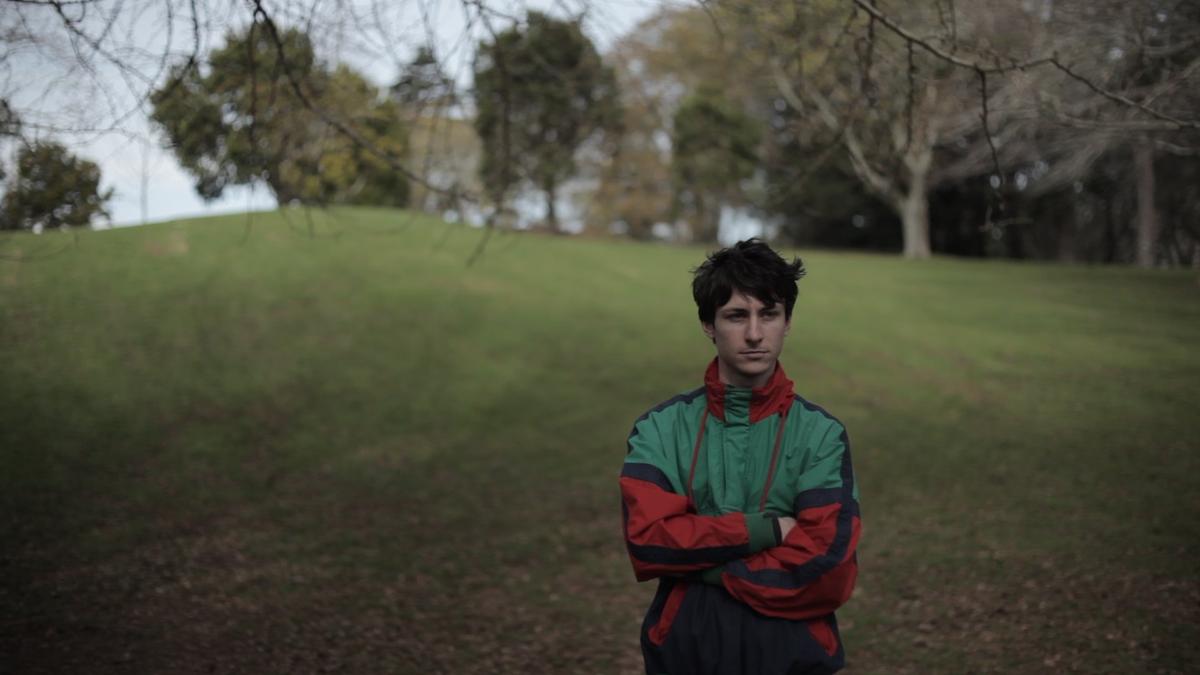I’m no expert on the genre of film noir. But I suspect it’s something most people have a basic awareness of, even if slightly misguided or clichéd, just like many people assume anything from the early-mid 20th century can be described as art deco. I’m probably working from stereotypical assumptions of noir too: self-generated (dim) lighting, long shadows, venetian blinds, deception and double-crosses, probably a detective story narrated in the first person by a gruff voice with an attitude about his ex-wife.
Tahi Moore’s solo Artspace exhibition AUTONOIR seems to match the type. The protagonists of the exhibition’s seven videos remain enigmatic and a subtitled narration in some clips (which are all silent) hints at a mysterious conspiracy, while the specifics of any further dialogue remain just out of reach. Monitors are installed at awkward heights and a stepped ramp constructed from raw timber dominates Artspace’s long gallery, offering a detour around the space that leads nowhere in particular and reveals nothing specific beyond the ramp’s ascent, while a fan placed underneath offers the show’s only sound.
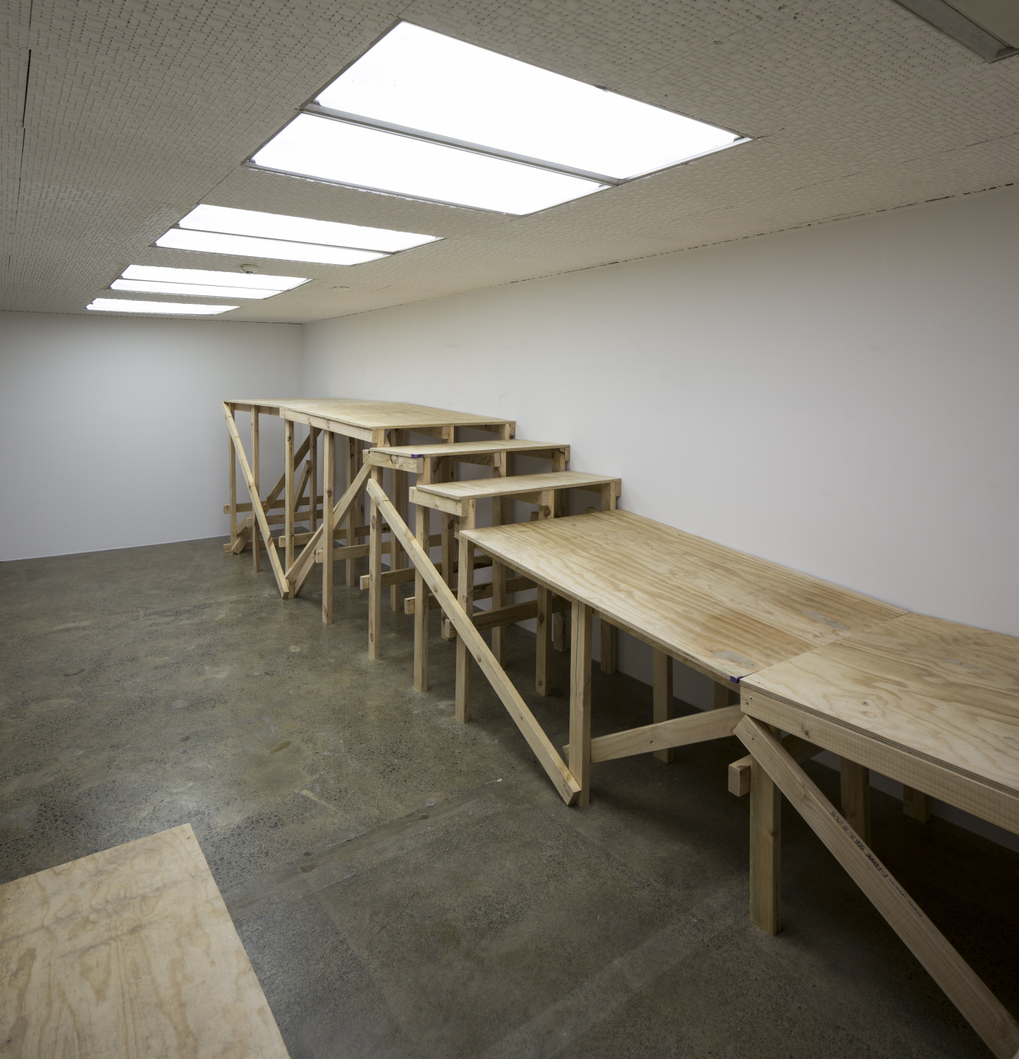
Installation shot in the long gallery. Photo: Sam Hartnett, Courtesy Artspace
The least accessible screen is in Artspace’s furthest corner, which has been partially blocked by the ramp. Viewers could stand on the platform and peer through the entrance. Or you could jump down and commit to entering the centre of the show, the inner sanctum of the maze. Inside is the exhibition’s title work, the shortest piece in the exhibition at 2’23”, mostly comprising images of the artist; video selfies shot in the dim yellow light of an old suburban home. There is also the overexposed glowing orb of a paper light shade and an unmarked beer bottle – the kind with the attached swing-top lid that home-brewers and boutique brands like to use.
Clues or red herrings? The artist himself is an evasive presence, shifting in and out of focus or slipping in and out of shot. He wears different garments, suggesting the video was accumulated over a period of time, or perhaps he is trying out different costumes or personas? There are close-ups of his shoes, shuffling forward or back across carpet, and a view from behind of what we presume to be the artist in a long woollen trenchcoat, probably also self-made—Moore is a consummate auteur, who even makes his own clothes. AUTONOIR is the only work in the exhibition where the artist reveals himself without the overlay of a suggested narrative, but what remains is an eerie emptiness. If this work is the key to the show, it is hard to tell what it unlocks, but that may just be the point.
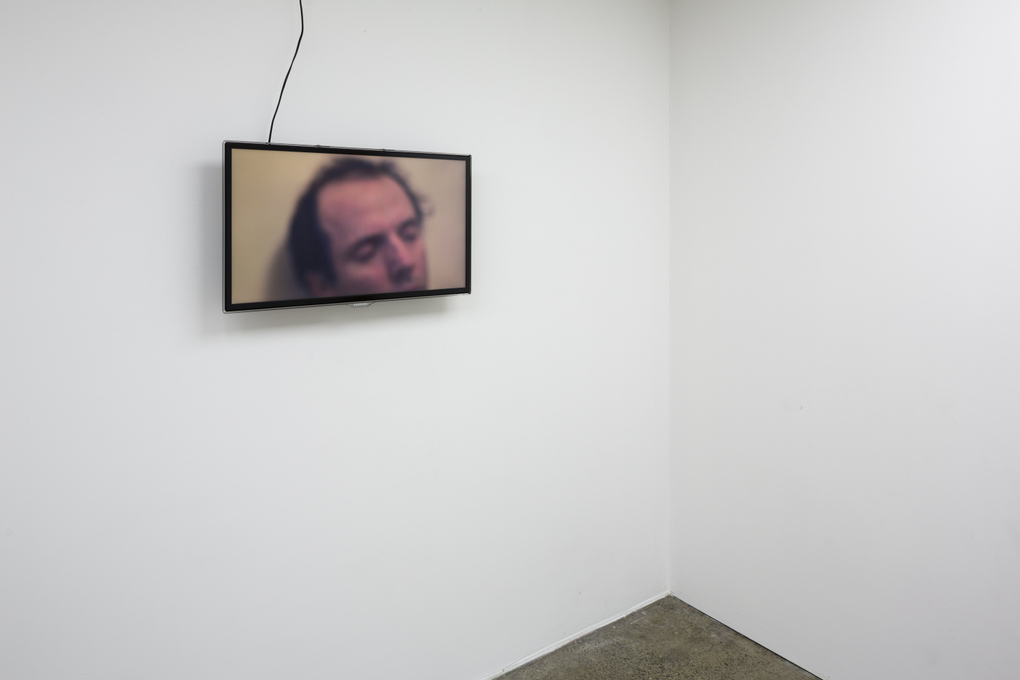
Installation view of AUTONOIR (2013) video 2’ 23’’. Exhibition photographer: Sam Hartnett. Photograph courtesy of the artist and Artspace
One room is painted grey and darkened, lit by a floor-standing workshop lamp, which throws raking shadows across the end wall in classic noir style, while also having the effect of slightly washing out the video projection. The video is titled Infinite Return, and features a group of young people (acted primarily by the founders of artist-run space Gloria Knight) alternately sitting around a coffee table talking, or out walking. The fact they are credited as actors confirms this is a constructed situation, that they are following instructions, possibly even reading a script. Their discussion is indicated by subtitles but the conversation we see is more detailed than the text provided, which functions more as a suggestion or placeholder. The actors pass around a container of pills, which could be vitamins but might also be something more potent. Perhaps they’re young beatniks, black-clad and waxing lyrical as they get high, much like surrealist and beat experiments in automatism. The next scene has them roaming in a rural field with the camera more distant and outside the group, who mostly remain out of focus. The subtitles here are more reflective, not relating the actor’s thoughts so much as a more external overview.
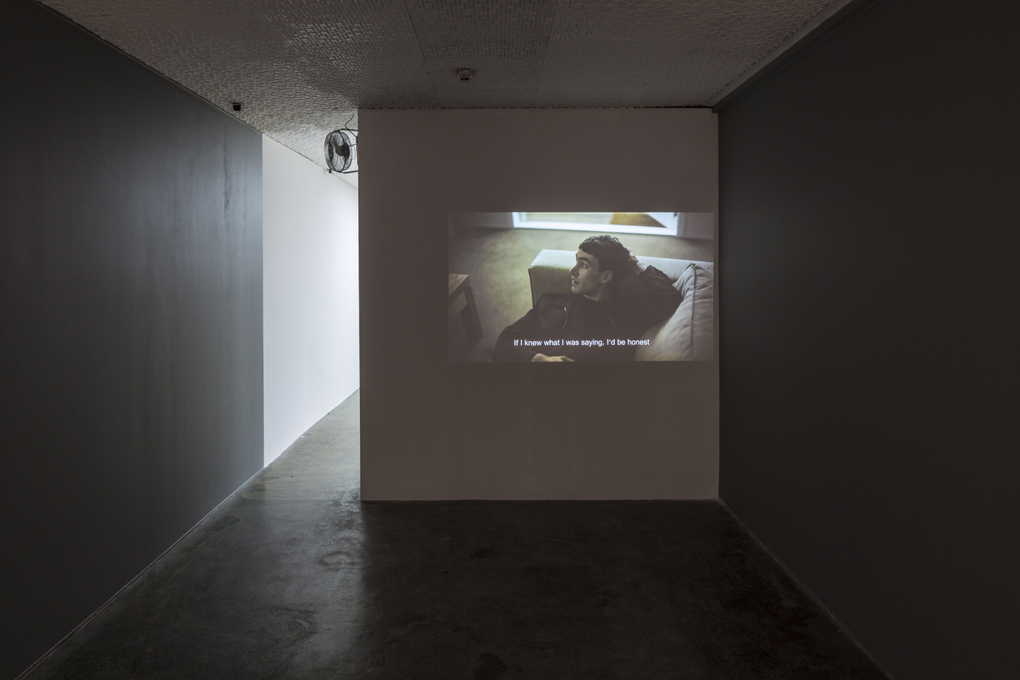
Installation view of Infinite Return (2013) video, 6’ 38’’. Actors: Henry Babbage, Juliet Carpenter, Ben Clement, Oscar Enberg, Francis Till. Exhibition photographer: Sam Hartnett. Photograph courtesy of the artist and Artspace
This use of text that doesn’t directly follow or explain the images recalls Chris Marker’s film essays, where disparate or contradictory images are woven together for juxtaposition with a narrated voice-over, which non-speakers of French would experience through subtitles. Similarly, Moore’s subtitled narrative emphasises the silence of his clips and reinforces a distance of meaning between text and footage, which remain ungrounded without their own acoustics, becoming more associative instead of explanatory or illustrative. This strategy of associative connections, rather than narrative development, recurs in Moore’s work and allows the elements of AUTONOIR to retain open-ended relationships.
Infinite Return has another brief scene that is in stark contrast to the rest of the exhibition, depicting a blackened landscape of blinking lights, reminiscent of the neo-noir sci-fi film Bladerunner (1982), although Moore's shot depicts an interior studio space, lit by the lights of electronic music equipment. The narration tells us about the construction of electronic music through the collage and layering of looped sequences. It could be a glimpse into the mechanics of the exhibition, like Marker folding his present self into the past narrative through self-referential descriptions of his image editing and contemplation of their meaning. The artist is present both in the film and making the film.
Of the different spaces that Moore has established to install his work in, the largest area in ARTSPACE’s main room has three screens. Cul-de-sacs is a backseat view through the front windscreen of a car as the artist traces his way through looping suburban streets that lead nowhere except in and out of dead ends. There are glimpses of the soft glow of a late evening horizon as the twilight fades but most of the scene is in soft focus except the driver’s headrest in the foreground. Although hypnotic, the (futile) motion becomes claustrophic, reminiscent of the tension in Hitchcock’s Psycho (1960) as Marion Crane slowly escapes from town. Moore’s constantly panning scene echoes the artificial views that are edited into Hollywood driving scenes, an artificial backdrop that often has the effect of inadvertently deconstructing the scene.
Also in the same room, The Island follows a similar theme, showing the artist picking his way around the rocky foreshore of what might be a small island, either looking for something or looking for a way out. There are low close-up shots of the beach, with tight focus on details, and long shots of distant landscapes across the sea. The sun is setting here too and trees are silhouetted, creating an ominous sense of urgency.
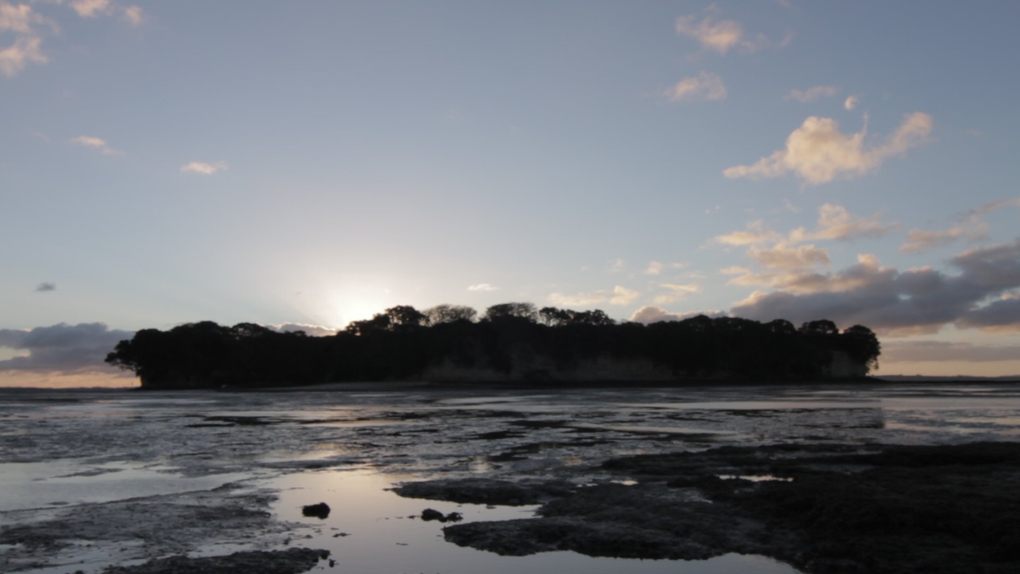
Still from The Island (2013) video, 8’ 49’’. Photograph courtesy of the artist and Artspace
The third screen here is Landscape 2, which is more ambient with images of cloudscapes but also introduces some rare narrative specifics from its subtitled narration. There is talk of traps of meaning, possibilities and probabilities, and dead ends. More explicitly, a man is described as hiding in Casbah and trying to get back to Paris, there is mention of an investigation into a crime and the involvement of shadowy military or corporate involvement.
As part of a multiscreen installation, it is hard to know whether to take this literally, to read it word-for-word as a story, and to presume it explains other works in the show. If so, should each screen be read/watched in its entirety, one after another, and in a fixed order? The unfolding of a noir mystery seldom lets chronology get in the way of a good story, jumping forward and back between flashbacks of the narrative’s past and present, as well as the narrator’s own present. It is, perhaps, an ideal genre for deconstruction through installation, read in any order the viewer chooses with a constantly reinvented looping temporality of juxtapositions. According to an information sheet, like the ramp, which is titled The Casbah, these are oblique references to 1937 French film Pépé le Moko, considered by some to be the first noir film. It would be easy to presume that Moore is playing the role of the film’s fugitive but it is more likely an additional layer to weave into the available readings.
With no single video in a dominant position, or the combination of them providing anything specific, like joining pieces of a jigsaw, it is difficult to capture this exhibition in sweeping statements or a tidy summary. Instead, the multiple screens seem to act as a form of diffusion or soft focus that makes you look harder at each one in its own right, reinforced by the non-standard installation of each screen in different environments. It problematizes the ability to consider them collectively as parts of a larger structure, except to simply describe a subjective experience of the work as one possible configuration.
While finishing this review, I found myself driving through a small coastal town that seemed to have been invented by developers. Streets curved in and out of each other without offering to go anywhere in particular, and even the beach was difficult to find, perpetually just beyond the next bend, with hardly a human to be seen. Everything was completely manufactured to fit the description on the real estate sign at the town’s entry, even the public toilet with its recorded voice and muzac to completely control the most primal and private experiences. It is exactly this kind of prescriptive Orwellian dystopia that Moore’s work tries to liberate, leaving out the manipulative soundtrack to let you think for yourself, and unbundling the narrative elements so they can be whatever viewers choose them to be.
